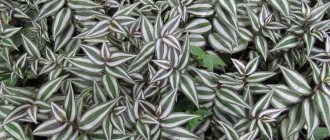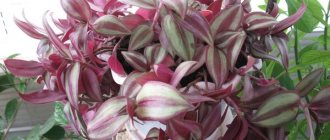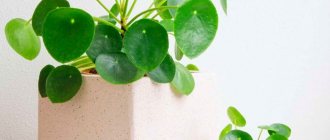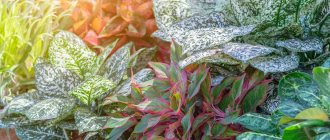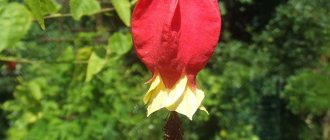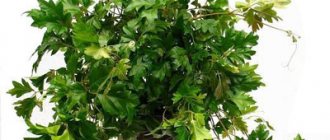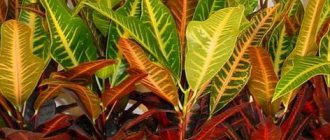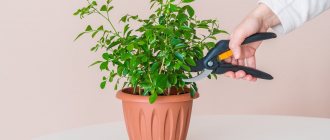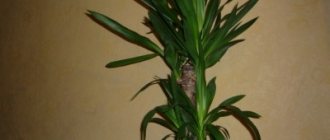Tradescantia: appearance, origin, distribution
In nature, Tradescantia is a perennial herbaceous creeping plant with long straight or branched shoots and oval or elliptical leaves located alternately on the stem. The flowers are mostly inconspicuous, small, white, pink or blue, located in clusters at the top of the shoot or in the axils of the leaves. In decorative floriculture, Tradescantia is valued for the beauty of its foliage, not its flowers. For the first time, botanical characteristics of this plant were given by the gardener of the English King Charles I, John Tradescant, whose name became the basis for the name.
Tradescantia comes from America, where different species of this plant are found from the northern regions of Argentina in South America to the border with Canada in North America.
Tradescantia is a perennial herbaceous creeping plant with long shoots
To successfully grow a plant in an indoor culture, you need to know the features of its growth in natural conditions:
- In its homeland, Tradescantia is considered a weed; it prefers swampy, highly moist soils, mainly peat. They are poor in nutrients - therefore, Tradescantia is unpretentious and does not require frequent feeding;
- The ideal climate for the plant is a warm and humid climate;
- The illumination of Tradescantia is not important - it easily tolerates both full shade and bright sunlight;
- As a plant of a tropical climate, in conditions of which it does not have periods of rest, Tradescantia is in the stage of active growth all year round.
Variety of types and forms of Tradescantia
Tradescantia has many varieties and forms, striking in its diversity. This is due not only to the wide distribution of the plant in various climatic zones, but also to the work of breeders. The most famous and popular among floriculture lovers are the following varieties, forms and types:
- Tradescantia zebrina, or zebra-shaped. One of the most popular and most famous species. This is a plant with drooping hanging shoots and multi-colored leaves: on the inside they are purple-violet, and on the outside they are green with white and silver stripes. Zebrina flowers are three-petaled and purple. One of the popular varieties of Tradescantia zebrina is Violet Hill. It is easily recognized by the central purple stripe on the outside of the leaf and silver inclusions.
- Tradescantia virginiana. As the name suggests, this species is native to Virginia. It is valued for its long flowering. Its flowers, unlike many other types of Tradescantia, are bright and beautiful. They are large, three-petalled, predominantly blue (color can range from white to pink-violet or blue). A distinctive feature is also the long, straight, lanceolate leaves. The shoots reach a height of 60 cm.
- Tradescantia Anderson. This is a hybrid formed by crossing Tradescantia virginiana with other species. The result was the appearance of a plant with decorative leaves and beautiful large flowers of various colors. The leaves of Anderson's Tradescantia are not only green, but yellow, purple, and variegated. Varieties with double flowers have been bred.
- White-flowered Tradescantia. The most common as a well-known houseplant. It has a drooping creeping stem and ovoid, pale green leaves with longitudinal white stripes, reaching 5 cm in length. In some varieties, the stripes may be golden or pinkish. White-flowered Tradescantia rarely blooms, its flowers are small and inconspicuous.
- Tradescantia myrtifolia (or riverside). It is distinguished by small elegant leaves, reaching 3.5 cm in length, located on a purple stem. The leaves on the inside are also purple in color; on top they are a rich green tone. The flowers are small, flowering is abundant.
- Tradescantia Blossfeld. It differs from other species in the shape of its leaves, pointed at the ends. Their length reaches 8 cm. The stems are thick, juicy, fleshy, creeping. The leaves are usually variegated: purple underneath, uniform green or green with white stripes and a pinkish tint on the outside. The flowers are pink, numerous, and formed at the ends of the shoots.
- Tradescantia sillamontana. Its peculiarity lies in the leaves, which are covered with a white coating, similar to a felt covering.
- Tradescantia hairy. This variety is rare. Its stems are erect, and its small leaves are covered with dense hairs that form a fluffy coating. The flowers are pink-lilac, bright.
- Tradescantia navicular. A very original representative of this family. It can be immediately recognized by its unusual leaves: juicy and fleshy, tightly pressed to the stems, slightly pubescent, pointed at the ends and boat-shaped.
Photo gallery: types of tradescantia
Variegated multi-colored leaves give a special “zest” to the zebrina
One of the most decorative varieties of zebra-shaped tradescantia, attracting attention with its unusual foliage colors - Violet Hill
Beautiful long-lasting flowering makes Tradescantia virginiana an excellent decoration for both home and garden.
Anderson's Tradescantia is indispensable for decorating gardens and cottages
White-flowered Tradescantia is easily recognizable by its decorative leaves with stripes of white, golden or pink.
The originality of Tradescantia sillamontana is due to the presence of a felt coating on the leaves
The most popular variety in indoor floriculture is the variety with variegated leaves that have a purple-pink coating on a white-green background - Tradescantia Blossfelda
Tradescantia pilosa is distinguished by the presence of hairs on the stem and leaves
Tradescantia navicularis got its name from the shape of its leaves, which resemble a boat.
Reo, or Tradescantia capillata
Reo belongs to the same family as Tradescantia - Commelinaceae. Previously, it was isolated as a separate genus of the family, but currently rheo is classified as a member of the Tradescantia genus. However, the external differences are very striking: the presence of rhizomes; thick, fleshy, non-drooping stem; elongated, hard, large leaves, reaching 30 cm in length and 5–7 cm in width. Reo leaves are colorful, bright - purple-red on the underside and lush green on the top. The flowering is very original: the flowers have the shape of a boat, formed by bracts, inside of which there are inflorescences collected from several small buds. Reo is valued for its decorative foliage.
Reo got its name in honor of a forest nymph. In addition to the main name, there are others by which this plant is known: Moses in a Basket, Moses' Boat, Moses' Boat and even Jesus' Cradle, received for the similarity of the shape of the leaves and bracts with the boat.
Reo is an atypical representative of Tradescantia
Description of the plant
In open areas, the perennial grows up to 30-40 cm. When grown indoors, in a container, it has a height of up to 20 cm. It can reach 50 cm in width.
The root system is located superficially and grows quickly. It is a dense, thick fibrous finger-shaped branch.
Young shoots are erect; as they mature, they begin to spread and take root on the soil surface. The color of the stems is purple-green.
The foliage is variegated, variegated, fleshy in structure. Oval in shape, pointed ends. Length - from 3 to 7 cm. The fastening is alternate, sedentary. The color of the upper part is olive, with a silvery tint; in bright light it looks red-violet; the lower part has a violet-purple tint.
Inflorescences are formed in the axils of the covering leaves, at the apical growth points. Most often single, occasionally paired. The corollas have 3 purple petals, up to 3 cm in diameter.
The fruits are a folded capsule with 2 or more seeds.
Bloom
The flowering period occurs in July and lasts about a month (possibly also in spring). With proper cultivation, with timely application of fertilizing, location in a place provided with sufficient light and heat.
The inflorescence blooms for 1 day, then withers, giving way to a new flower.
This is interesting: the leaves and stems of Tradescantia sillamontana are covered with white hairs that resemble cobwebs or felt. They protect against sunburn and excessive evaporation of moisture. The pubescence gave the flower a second name: White Velvet.
Table: keeping tradescantia at home
| Lighting | Humidity | Air temperature | |
| Spring Summer | The ideal place for growing Tradescantia at home would be a western or eastern window. When located on the south side, shading is necessary. On a window facing the north side, there is an increased likelihood of shoots stretching, leaves losing their decorative properties, and a decrease or complete absence of flowering. It should be noted that different varieties require different conditions. For example, Tradescantia, which has hairy leaves, tolerates direct sunlight well, which can cause burns on the leaves of more delicate varieties. Variegated forms are more sensitive to light: bright rays of the sun can cause leaves to turn pale, and deep shadow can cause a change in pattern. | High air humidity has a positive effect on the growth and development of Tradescantia. The plant responds well to frequent spraying of the leaves. | 20–25°C. |
| Autumn winter | In winter, when central heating radiators greatly dry out the air in city apartments, using a humidifier will be very useful for the plant. | The plant tolerates temperature changes up to 12°C. If possible, it is better to provide Tradescantia with a cool winter. However, the plant grows well all winter without a dormant period. |
What should the lighting be like?
Tradescantia grows best on the western and eastern sides. With this arrangement, it receives enough bright light, but in a diffuse form. The plant also feels good near windows on the north side; the south side is not suitable for it, and if you decide to place it on this window, then during hot hours you need to cover the plant from the sun.
Tradescantia with variegated leaves is more demanding of light; if there is not enough light, then the leaves become simply green, and if there is too much, they burn out. The most shade-tolerant is the white-flowered Tradescantia species. In summer, the plant can be taken out to the balcony or planted in the garden.
Transshipment and transplantation of Tradescantia
During transshipment, the earthen ball with roots is not destroyed, but during replanting, the old soil is completely replaced by new one. Thus, transshipment is more gentle for any plant.
Transshipment of plants
Transshipment of a plant is usually carried out when it needs a more spacious pot. This can be determined by the roots, which, as they grow, entwine the entire earthen lump and begin to peek out from the drainage holes at the bottom of the pot.
Transshipment is carried out as follows:
- You need to choose the right new pot for the plant. The size of the container is determined as follows: between the old pot and the new one, if you place them one inside the other, there should be a distance of 1–1.5 cm. Tradescantia prefers shallow and wide containers.
- The substrate for Tradescantia should be quite loose and nutritious. Any ready-made universal soil sold in stores is suitable for it. If you wish, you can make the mixture yourself by taking soil, peat and sand in a 2:1:1 ratio. A drainage layer of 1–2 cm is necessary to eliminate excess moisture during watering and creates optimal conditions for the development of the plant’s root system. You can use any material that allows water to pass through: sand, expanded clay, small shards, broken brick, crushed stone, gravel.
- The earthen ball of the plant must be moist before transshipment.
- The plant must be removed from the pot along with the lump of earth without disturbing it. To do this, they use techniques such as turning the pot upside down while simultaneously tapping on its bottom. If the pot is soft (for transportation), you can gently crush it on all sides, gradually moving the earthen lump outward.
- The top layer of soil must be shaken off as much as possible.
- In a new pot, you need to pour a layer of substrate onto the drainage layer so that the earth ball can be placed in such a way that the root collar is 2-3 cm below the level of the surface of the pot.
- Place the plant, fill the gaps between the pot and the lump of earth with roots with the soil mixture, making sure that there are no voids left. The soil needs to be well compacted.
- Water the Tradescantia well.
Transshipment is a gentle method of replanting indoor plants
Transfer
Transplantation will differ from transshipment primarily in that the integrity of the earthen coma is violated, rotten roots and old depleted soil are removed. Typically, the need for replanting occurs once every 2–3 years (or in cases where the plant is sick).
To properly transplant Tradescantia you need:
- Prepare the new pot, soil mixture and drainage in the same way as for replanting.
- The plant must be carefully removed from the pot, gradually shaking the earthen ball, and carefully separate the roots from the soil and from each other.
- Carefully examine the roots, remove dry, diseased or rotten parts.
- Plant tradescantia in a new pot with prepared drainage and substrate. The soil mixture should be poured gradually, straightening the roots, and making sure that the soil is evenly distributed between the roots. Compact the soil.
- Water the plant.
Video: how to transplant tradescantia
Landing rules
For planting, choose a wide, not very high clay or ceramic container. It is desirable that there is no decorative coating on it, and that the walls have good breathability.
Drainage material is placed at the bottom:
- Styrofoam;
- small pebbles;
- expanded clay
This will protect the flower from stagnation of moisture, leading to the development of a fungus on the roots - fungal rot.
Important: if Tradescantia is planted in a plastic pot, it is necessary to regularly loosen the soil to avoid lack of oxygen to the root system.
Care
Tradescantia is a plant that tolerates unfavorable conditions well. If you do not have the opportunity to do regular care, then Tradescantia will survive this. But if you want to get a beautiful lush bush, then you should not neglect the rules of care.
Ruellia also deserves attention for its unpretentiousness and ease of care:
Watering
Tradescantia is a moisture-loving plant. The intensity of watering depends on the time of year, humidity and air temperature. An indicator of the need for irrigation is a slight drying of the surface of the earthen clod. At high air temperatures, watering is usually necessary once every 2 days, at lower temperatures - once a week.
Water for watering Tradescantia should be soft and allowed to stand for several days.
Top dressing
Feeding Tradescantia is mandatory during the period of active growth, namely from March to September - October. In winter, if the plant has a dormant period (it is kept at low temperatures), fertilizing is not needed. If in winter Tradescantia is located in rooms with high air temperatures, and there is no dormant period as such, then fertilizing can be continued, but its frequency can be reduced.
Any complex mineral fertilizer is suitable for fertilizing Tradescantia. The frequency is usually once a week in the summer, and once every 2-3 weeks in the winter.
Recent Entries
Lilac perennials that are beautiful, compact and do not crowd out other plants Why when buying seedlings you should not take the sellers’ word for it and how to determine the age of the plant using 3 signs Tomato seedlings have turned purple or whitish: why the color has changed and how to save the plants
To fertilize Tradescantia, any complex fertilizer that can be purchased in the store is suitable.
Flowering period
Although Tradescantia is mainly grown for its beautiful cascading shoots with colorful decorative foliage, the flowering of most varieties is also of interest. White, purple, pink or blue small flowers located in the axils of the leaves and at the ends of the shoots, combined with the rich color of the foliage, give the plant a special charm. The flowering of indoor Tradescantia can be stimulated by cold wintering, reducing the frequency of watering, and changing lighting conditions.
If the problem of inconsistent flowering has arisen in garden varieties of Tradescantia, then most likely it is due to unfavorable growing conditions, insufficient watering, and the need to renew the plant (usually every 4–5 years).
Flowering of indoor tradescantia can be stimulated by cold wintering and reducing the frequency of watering
Features of preparation for winter
For indoor Tradescantia species, wintering and the dormant period are not particularly important, although this is preferable. If it is not possible to find a place with a temperature from 12°C to 15°C from November to March, then Tradescantia will grow in winter, delighting with the greenness of its shoots.
For garden tradescantia, everything is completely different. After the end of the growing season, it must be prepared for wintering: cut off the above-ground part of the plant and sprinkle (mulch) the soil with peat or humus. Otherwise, the plant may not survive the winter period.
Tradescantia in the garden needs to be prepared for wintering: cut off the above-ground part of the plant and mulch the soil with peat or humus
Formation of Tradescantia
Pinching Tradescantia should be done regularly - it helps tillering, the formation of side shoots, and improves appearance. With age, the plant loses its decorative effect: the shoots become bare and the leaves dry out. In this case, pruning will help. New young shoots will emerge from the root, and the cut stems can later be rooted.
Plant support
Most often, Tradescantia is grown in hanging pots or cache-pots as an hanging plant - hanging lashes of green or variegated leaves look impressive. But there are options for unusual uses of tradescantia for room decoration. For example, using mounts for tradescantia stems on the wall, you can create an unusual living decorative wicker decoration. An interesting option would be to use a vertical support.
Various supports for Tradescantia can be used to advantage in room decor
Creation of a florarium
The care conditions required for Tradescantia make it possible to use this plant to create compositions for a florarium - a closed ecosystem in an aquarium or bottle. Tradescantia's good relationship with high soil and air humidity makes it an excellent plant for a tropical florarium.
The most famous and unusual florarium with tradescantia was created by English amateur gardener David Latimer. His “garden in a bottle” with Tradescantia has been growing closed for 40 years! The plant filled the entire volume of the bottle, and was watered only 2 times: when planting and 10 years after it.
Tradescantia has been growing in the florarium of florist David Latimer for several decades.
Table: mistakes in caring for Tradescantia
| Problem | Cause | Corrective Action |
| The tips of the leaves dry out. | Dry air. | Increase the humidity in the room or spray Tradescantia frequently. |
| The leaves are turning yellow. | Little moisture. | Increase watering. |
| Variegated leaves turn green. | The plant does not have enough light. | Move to a more illuminated place. |
| The stems stretch out and the leaves become smaller. | A sign of lack of lighting and feeding. | Adjust the feeding regime, provide Tradescantia with more light. |
| The stems at the base became soft and turned brown. | Rotting of the stem and root has occurred. This occurs when Tradescantia is overwatered or watered with too cold water. | At the initial stage of decay, you can try to save the plant by cutting and rooting healthy parts of the stem. |
| Faded color of leaves. | Excessive lighting. | Move the plant to a more shaded place. |
Photo gallery: the result of mistakes in caring for Tradescantia
The cause of dry leaf tips is insufficient air humidity.
Tradescantia leaves turn yellow with insufficient watering
The plant should be protected from direct sunlight to maintain the bright colors of the leaves.
Beneficial features
In modern floriculture, various exotic plants have become very popular, and for some reason Tradescantia began to be considered too simple a flower and began to disappear from home collections. Although, thanks to the varied colors of the leaves of different varieties, it is quite decorative.
In addition, this flower has a lot of medicinal properties. It is worth having it in your own home, because it protects it from negative energy. Tradescantia domestica will become your protector from evil tongues and will absorb all the envy and gossip of your enemies.
In addition to emotional, this flower will also have an impact on your physical form, as it will serve as a filter for the air in your apartment and at the same time as an air humidifier. By absorbing all harmful substances and simultaneously releasing moisture, Tradescantia makes the air clean and healthy for the human respiratory system .
It is especially useful to keep Tradescantia in the kitchen in order to protect yourself from the harmful effects of electrical equipment.
In medicine, the leaves of the plant are used to treat boils and purulent wounds. This plant also has the ability to resolve hematomas and heal wounds. Rinsing with a decoction of leaves is used for periodontal disease. Tradescantia indoors is used internally as an anti-diarrheal agent. In some countries, diabetes and tuberculosis are treated with its help.
Tradescantia is a real home healer. Fresh leaves are applied to wounds, hematomas, boils to relieve inflammation and prevent suppuration. For diarrhea, 3 tablespoons of leaves are brewed with a glass of boiling water and taken 2 times a day before meals. If the tonsils are inflamed, it is recommended to lubricate them with Tradescantia juice several times a day. For a runny nose, the juice is used in the form of drops.
Tradescantia leaves are very popular with cats. Therefore, if you do not want all the leaves to be eaten, move the flower higher and let your cat chew the leaves sometimes as a treat.
Is it possible to keep a Tradescantia flower at home? It's certainly possible. However, there is an opinion that all climbing plants, and Tradescantia is one of them, drive men away from home and even lead to a complete loss of love.
You can learn more about the medicinal properties and contraindications of Tradescantia in the video below:
Pay attention to other types of indoor plants, which also have a lot of useful properties. For example, the “home birch” Roisissus, the ornamental plant Alocasia, popular for its medicinal properties, the sacred tree among Muslims Ficus, and also popular among people under such names as “Mother-in-law’s tongue”, “Snake skin”, “Pike tail”, a very unpretentious plant Sansevieria.
Diseases and pests of Tradescantia
If the plant withers, dries out and loses its attractive appearance, you should check to see if pests have appeared on the bush.
Table: typical diseases and pests
| Pests and diseases | Signs and symptoms | How to fight |
| Aphid | Damages young shoots and leaves. In this case, the shoots die, and the leaves lose color and curl. A sticky coating appears. | Spraying with special insecticides (Aktellik, Fufanon, Fitoverm) or a solution of laundry soap or washing powder. For prevention, it is recommended to repeat the treatment after 2–3 weeks. |
| Shchitovka | The appearance of small brown plaques on the leaves and stems. Leaves turning pale and falling off. Sticky coating. | Mechanical treatment - wiping the stems and leaves with a sponge and soapy water, spraying with insecticides. |
| Trips | They are small in size, so they are not easy to detect. Colorless or yellowish spots appear on the leaves, and the leaf dries out. Small black dots are visible on the underside of the leaf blade. |
|
| Spider mite | The appearance of cobwebs on the underside of the leaf and in the internodes, which is especially noticeable when spraying. The plant withers, the leaves turn pale and fall off. |
|
| Sooty mushroom | Appears on the outside of the leaf in the form of a dark-colored film. Disturbs the plant's breathing pattern. Often its appearance is associated with the presence of other pests, as it settles on the sticky secretions of aphids, scale insects and thrips. |
|
Photo gallery: signs of pest infestation
With severe infestation, small insects of green, black or gray color are visible
The appearance of small brown growths on leaves and stems means infection with scale insects
Thrips are small black insects that are not easy to see
One of the main signs of a mite is the web it leaves on the underside of leaves and stems.
Dark coating on the leaves is the main symptom of sooty fungus infection.
Tradescantia propagation
Tradescantia is propagated by seeds and cuttings.
Cuttings
The easiest and most convenient way to propagate Tradescantia is by cuttings. Its shoots quickly and easily produce roots and subsequently take root. In this way, Tradescantia can be propagated from early spring to late autumn, excluding only the winter months, when root formation is very slow. Young shoots of Tradescantia with a length of at least 15 cm are suitable for cuttings. They take root well in ordinary warm water at air temperatures above 20°C. After the roots appear, the cuttings are planted in the soil substrate in compliance with all the requirements for planting: drainage, optimal soil mixture, suitable pot volume, timely watering.
Planting several shoots in one pot at the same time gives the plant a special decorativeness and splendor.
Young shoots of Tradescantia with a length of at least 15 cm are suitable for cuttings.
Video: propagation of Tradescantia by cuttings
Seed propagation
Propagation of Tradescantia by seeds is not as popular as cuttings, but no less effective. It is often used for growing garden species. Planting the plant with seeds is carried out in the spring, usually in March. Seeds are planted in a prepared container with soil substrate (the best option would be a light and loose mixture of peat and sand in a 1:1 ratio) or in peat tablets. The soil should be moist, but not soggy. The seeds are scattered over the surface of the soil and slightly covered with the substrate on top. The container with seeds must be covered with plastic film or glass, creating the effect of a greenhouse with constant humidity and temperature. The emergence of seedlings should be expected no earlier than 2 weeks after planting. Subsequently, the seedlings are planted in separate pots. This procedure is carried out after the appearance of the third leaf.
Tradescantia grown from seeds will bloom 3 years after planting.
The appearance of the third leaf is a sign of Tradescantia’s readiness for transplantation.
